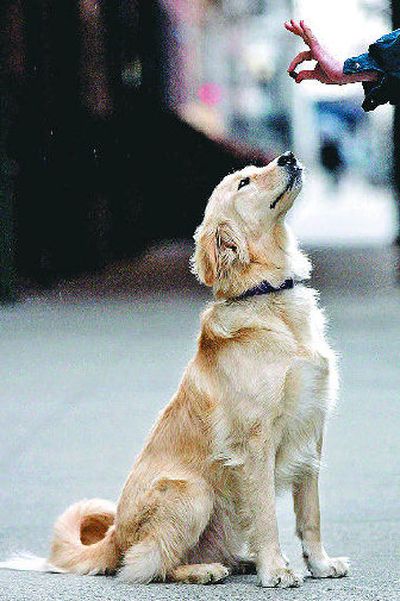Take control with key command: Sit

Trying to teach your dog some manners?
Try getting him to learn one magic command instead: Sit.
After housetraining, “sit” may be the most important thing you can teach your dog. Once your dog learns that sitting earns him a treat, you hold the cure to many problems, dog trainers say.
“The dog doesn’t get any of life’s rewards unless she sits first,” said Mary Sullivan, a professional dog trainer in Silver Spring, Md. “Ask for a sit before putting on a leash for a walk, opening the back door, or putting down the food bowl.”
Once you’ve gotten the hang of this, you’ll begin to see that many undesirable behaviors persist because you’re inadvertently rewarding them.
For example, your dog scratches at the door when he wants to go out. And why not? Whenever he scratches, you let him out.
“Any behavior that is rewarded will increase in intensity and frequency,” said Janine Pierce of J9’s K9s dog training school in California’s San Fernando Valley.
What you need to do is substitute the behavior with one that you want.
“It’s the ‘nothing in life is free’ program. Like asking a little kid to say please,” she said.
Here’s the prescription: Your dog scratches at the door to go out. You ask for a sit, and open the door only after the dog is sitting. Soon he will learn that sitting causes the door to be opened – and just as importantly, scratching accomplishes nothing.
You can apply the same technique to any behavior you’d like to change, like the common problem of your dog jumping up to greet people.
“Almost every client I have calls me because the dog is jumping up,” Sullivan said.
So ignore the dog when he jumps for attention. But pet him when you ask him to sit and he responds.
“Dogs will always do what’s in their own best interest,” said Pierce. The trick is “making the incompatible behavior more rewarding than the undesirable behavior.”
Of course, all this presumes that your dog can sit on command. If your pet still needs to learn this all-important skill, here’s a crash course.
The easiest way is to lure the dog into the position with a treat.
“Take a piece of food and hold it over their nose until they fall into a sit,” said Sullivan. Move the treat toward the dog’s back if necessary to get him into the position. Then give him the food the instant his bottom hits the ground.
As soon as possible, move the food to the other hand and lure the dog with the empty hand – “air cookie,” Pierce calls this. Say “good dog” when he sits and immediately feed from the other hand.
Once the dog is sitting regularly with the hand lure, teach the verbal command by saying “sit” simultaneously as he hits the floor.
Then you should gradually be able to switch from luring with the hand while saying the word, to using the verbal command alone.
Dogs have so little control over their world. When they learn that sitting can get them something they want, the payoff can be huge.
And besides, no matter how talented your dog is, he can’t do something mischievous and sit at the same time.